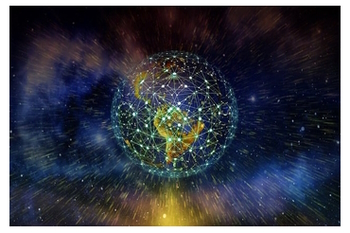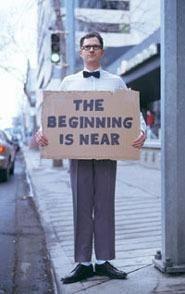
We like predictions, particularly if we like the outcomes. We all want the winning lottery ticket because we want that outcome for a small investment. As individuals, we like to beat the odds. Collectively it breaks up into groups who want certain outcomes, and wars have been fought and continue to be fought over certain outcomes.
In fact, in conversation with a friend over coffee a few days ago I mentioned that in watching a documentary series on chimpanzees, their social groups have territory that they patrol and fight over, which include the richest fruit trees. In this regard we are not too different, we simply fight over other things. If we fought over trees, our world would likely be much different, more lush, with what we would consider less progress.
When I summarized the technological singularity, I didn’t really mention the other predictive models out there about other things because the technological singularity was a focal point. That’s the trouble with predictions. They have a tendency to omit other data. Let’s go with the 2045 technological singularity prediction, based predominantly on technology. What other factors will impact humanity by 2045?
There’s population, which I was surprised to find has decreased in growth rate. By 2045, though, we should have a global population of about 9 billion people – but here’s where it gets interesting.
Many factors contribute to the waxing and waning of the world’s population, such as migration, mortality, longevity and other major demographic metrics. Focusing on fertility, however, helps to illuminate why the total number of humans on Earth seems set to fall. Demographers define fertility as the average total number of live births per female individual in a region or country. (In the accompanying graphics, the term “woman” is used to encompass anyone assigned female at birth.) The U.S.’s present fertility rate, for example, is about 1.7; China’s is 1.2. Demographers consider a fertility rate of 2.1 to be the replacement rate—that is, the required number of offspring, on average, for a population to hold steady. Today birth rates in the wealthiest countries are below the replacement rate. About 50 percent of all nations fall below the replacement rate, and in 2022 the region with the lowest fertility rate (0.8) was Hong Kong.
Katie Peek, “Global Population Growth Is Slowing Down. Here’s One Reason Why“, Scientific American, December 7, 2022, (emphasis mine)
For simplification, we look at only the fertility metrics. Migration prediction is a mess because of laws and lines drawn on maps long ago. The data, however, demonstrates a decline and yet in the same article we see something interesting along those lines, which points to a need for migration.
High-income nations now have the lowest birth rates, and the lowest-income nations currently have the highest birth rates. “The gap has continued to widen between wealthy nations and poorer ones,” says Jennifer Sciubba, a social scientist at the Wilson Center in Washington, D.C., who has written about these planetary-scale demographic shifts. “But longer term,” she says, “we’re moving toward convergence.” In other words, this disparity among nations’ birth rates isn’t a permanent chasm. It’s a temporary divide that will narrow over the coming decades.
Katie Peek, “Global Population Growth Is Slowing Down. Here’s One Reason Why“, Scientific American, December 7, 2022, (emphasis mine)
How could we move toward that convergence without migration, particularly with economic disparity increasing even as we claim global poverty is diminishing? The global economics of nations has a role to play here as well. It’s not hard to see how the global population by itself might be around 9 billion in 2045, but where will those people live, and how will they live?
Let’s factor in something else, such as sea water levels. We attribute much of it to climate change. Pumping water out of aquifers faster than they can replenish is also a factor. I also stumbled across a few articles about how trees seemingly bend the laws of physics in storing water, and since a tree is roughly 50% water by mass, every time we cut down a tree half of it’s mass is released into the atmosphere as water.

It is interesting to note that as we cut down trees, we not only affect the ratio of gases in the air, a living thing by itself, but also release that moisture into the atmosphere where it will likely end up in the ocean that will contribute to sea level rise. How much is that? I don’t know, but since we have been doing it for generations I expect that it has been a significant amount.
Where do we find water to irrigate new tree growth when we plant them? Rains, the local aquifer, etc. Planting trees may well pull moisture out of the air, but does it do so at a rate greater than we pump water out of the ground to irrigate them?
And how much water do we store in our bodies? Roughly 60% of our body is water, and assuming a 75kg (approximately 165 pounds) person, each person would have about 45 liters (12 gallons) per human. We also store water. When we get buried, it goes into the local aquifer, when we get cremated, it goes into the atmosphere.
To maintain that level of water in our systems, which we conveniently find all over in plastic bottles these days, we need 3.7 litres (men) or 2.7 litres (women) per day. With a population of over 8 billion at this time, that’s a lot of water, and desalinization seems a great idea for assuring a better replenishment of the aquifers we’re pumping water out of. Yet we are bound by our own economics in this regard, about how cost-effective it is to do these things, particularly in less economically advantaged nations.
Oh, and we’re looking at increasing to 9 billion humans around 2045, but that number is based on fertility alone. There are a lot of other factors, which include water – which is also another factor.
Toss in politics and geography of materials for technology, it’s hard to look at a prediction like that of the technological singularity and be a bit boggled by the hubris. Now, if we could get all this data from all these silos to interact in ways that are cross-disciplinary, which an artificial intelligence could be good at, we might get less imperfect predictions.
That might be a great use of AI.




